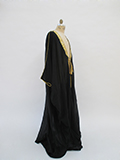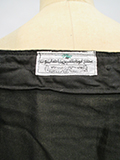Overview
A bisht is a “large square-cut, floor-length cloak made of finely woven camel hair or wool and trimmed with black cord or gold braid” according to Patricia Rieff Anawalt in her book, The Worldwide History of Dress, on page 595. They are finely made and can be expensive, especially when tailor-made from camel hair. However in modern times a bisht can be bought ready-to-wear in an array of neutral colors including white, beige, cream, brown, gray, and black. It can be ornamented in a variety of ways often with gold and silver embroidery.
Most sources concur that the bisht is traditionally menswear, particularly for upper-class men. However, the Blue Abaya, a blog started by a Finnish nurse living in Saudi Arabia, reports that bishts can be purchased in a multitude of colors for different people at a variety of prices. Her blog includes references to different stores where she looked for a winter coat in December 2015 and where she found bishts in pinks, purples, and even bright blues, all colors aimed at and marketed for women.
The bisht in NowesArk was made for a man. It is black and long-sleeved, and is ornamented with gold trim. It is floor-length. The gold trim that appears throughout the entire garment changes in terms of width, color, and intricacy. Around the neck and about halfway down the front of the garment, the border is woven from gold, silver, and red threads. It then gets narrower and is woven from solid gold thread. The most decorated part of the border has a pattern of silver diamond-shaped structures with a silver shape that looks like a bow tie, with four distinct corners, as can be seen in Figure 2 below.
Materials and Dimensions
The bisht is made from lightweight black cotton making it ideal for wearing over other clothes as a means to be warm in cool weather and for protection from blowing sand. The garment can also be worn for its decoration and embroidery.
The trim is synthetic; the cord used on the borders and sleeve edges is different than the braid along the back of the neck and extending down center front. It is predominately gold with some silver rectangular elements and narrow red lines. The tassels appear to be made from spun metal (the fibers are malleable and change shape if you bend them). The tassels were formed by winding spun metal into a ball and attaching three running tails. They are bound on top with black cotton thread. These tassels measure 8" in total length with about 6" of that total being the length of the tails. The tails are not all the same exact length varying by 1/8" from one another. The ball portion of the tassel has an approximately 3/4" diameter.
The garment is floor length and would be appropriate for someone 5' 6" or taller. It measures 61" from the neck to the floor at center front. The length from the bottom edge of the arm opening to the floor measures 56 1/2 inches. The garment is also quite wide. The length around the bottom is 123 inches. The wingspan, the length of the garment from the end of one sleeve to the other, is even longer than the length. It measures 61 1/2 inches. The long sleeves extend to the wrist where a narrow opening accommodates the hands.
Figure 1: Front Opening |
Figure 2: Embroidery Detail |
 |
 |
Construction
The machine-made bisht is constructed from three pieces of fabric, one for the back and two in the front. There are only two sets of seams that essentially hold the garment together. These seams run across the top of the the length of the shoulders and under each arm. Narrow gold trim covers the seams and also adds interest and a geometric appearance by straightening the way the arms look. They measure 25 inches from neckline to sleeve end. This trimming also encompasses both cuffs, as seen in illustration 3 below. The cord is narrow, about 1/4" wide.
Facings made from self-fabric reinforce and support the wide braid that decorates the front and back neck of the bisht. A dense, braided, twine-like reinforcement has been sewn inside along the top seam of the sleeves to keep them from collapsing and looking flimsy on the arms.
The garment is hemmed around the bottom edge by machine. The fabric was folded under a couple of times, and then ironed to give it a crease. The hem is machine sewn in two parallel lines to give it stability and secure the raw edge. The narrow hem measures about 1/4 inch wide.
Ornamentation
The bisht has embroidery down the front in an intricate pattern. The underside of the embroidery, inside the bisht, is reinforced with a 4"wide facing made of the same black cotton fabric as the rest of it. It is held in place with four rows of machine stitching. At the widest point, the embroidery is two inches wide. This same embroidery extends 9 1/2" across the back of the neck, from shoulder seam to shoulder seam. Approximately 16" inches below the neckline in the front, the border narrows to approximately 1/4" wide. The decoration on the more widest part of the border, which looks like bow ties, measures about 1 inch wide and 5/8 inch tall. The smaller silver diamond decorations measure about 1/2" wide and 1/4" inch tall. Figures 1 and 2 above illustrate these elements.
The embroidery was carefully positioned machine-sewn with golden yellow cotton thread. The patterns are symmetrical on both sides. At the place where the embroidery narrows, making a point before shifting to the thinner material is not the exact same width on both sides, although the variation is less than 1/8 inch. A small amount of a red line also shows more on the right side than on the left.
Figure 3: Opening for Hand |
Figure 4: Detail of Tassels |
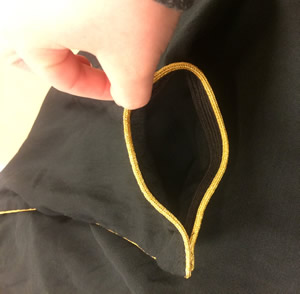 |
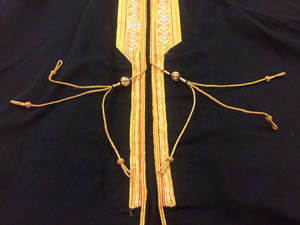 |
Provenance
There is a tag on the inside of the neck of the garment printed in Arabic, as can be seen in the Figure 5 below. It is white with black lettering in a somewhat stylized font. The dimensions are 3 inches by 1 1/8 inch. The tag is also most likely made of a synthetic material, and it was quickly sewn on by machine with somewhat crooked lines of stitching. The font made it difficult to read the Arabic words, but a professor in Asian Studies, Dr. Nadia Yaqub who is fluent in and teaches courses in Arabic translated the tag as saying, “The Shut (or Shoot) factory of Abu Dhabi for weaving and sewing. Tel: 341162 P.O. Box 728. Abu Dhabi, UAE.” Her colleague, Farida Badr, a lecturer in the same department, translated it similarly. Unfortunately, on line searches online did not provide any further identification of the source.
Figure 5: Label |
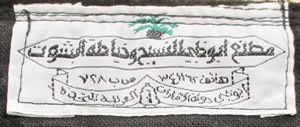 |
Sources and Cost
Ready-to-wear bishts can be purchased online by providing a vendor with one’s measurements. They do not come in as wide of an array of colors when purchased this way, however, and tend to be in the neutral colors and earth tones that the bisht was made in traditionally. Also, sometimes when purchased this way, the bisht comes in one size, and leaves it up to the buyer to tailor it as necessary to find the perfect fit. They can be expensive, even when they are not made of the finest camel hair. The least expensive ready-to-wear bisht from an online vendor was made from a cream filmy synthetic material and cost $36.99. A search for bisht made from wool costs around $125.00.
Summary
The bisht is traditionally worn by men, but can also on occasion be worn by women, especially in modern times. It is an outer garment, has some ornamentation, and generally is a solid neutral color. It is worn over other garments and has no method of closure except for a set of tassels in the front, at about waist height.
© Stephanie Beckett, Class of 2016
Drama 475.001, Spring 2016 Semester
University of North Carolina at Chapel Hill


